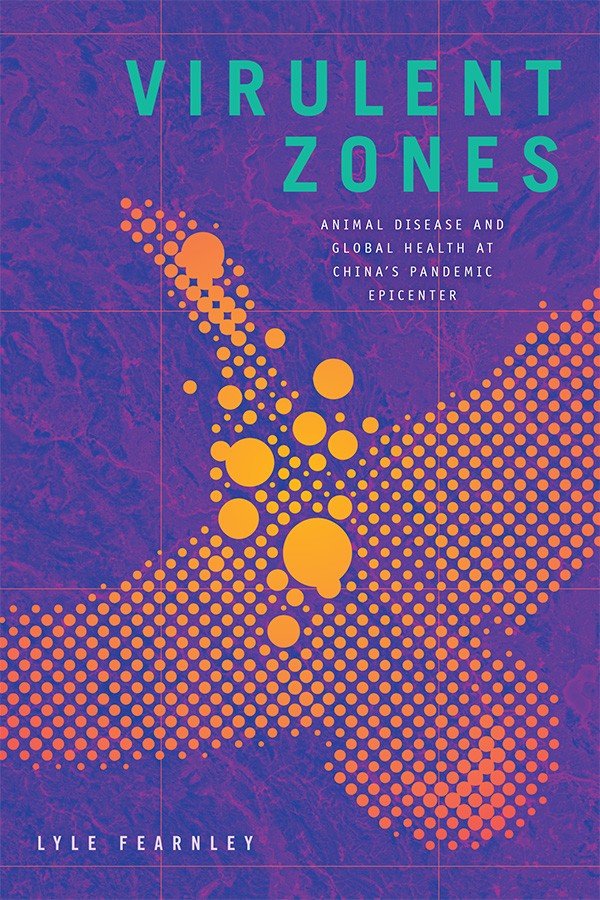Reviewed Book
Virulent Zones: Animal Disease and Global Health at China’s Pandemic Epicenter, Lyle Fearnley, Durham: Duke University Press, 2020, 288 pp.

Theresa MacPhail
Stevens Institute of Technology
For the past 30 years, global public health practitioners have sought to answer a foundational question of the field: How do novel microbes emerge? Answers to this central question are seen as crucial to the prevention of mass outbreaks of infectious disease. Nothing has highlighted the pressing need for more microbial surveillance programs and international information-sharing networks more than the current COVID-19 pandemic. The SARS COV-2 virus has been the focus of intense scientific research, aimed not only at understanding its biological functions, but at discovering its origins. Intense scrutiny of Chinese food production methods and consumption habits (particularly around the eating of so-called wild or exotic animals), where the virus is thought to have first emerged, have been at the core of an international scientific search for answers. In his new book, Virulent Zones: Animal Disease and Global Health at China’s Pandemic Epicenter, Lyle Fearnley gives us a new entry point for understanding our obsession with the origins of pathogens and for thinking more analytically and historically about local, national, and international virus surveillance networks.
Fearnley’s book is an extension of much prior work done in medical anthropology on global health networks, preparedness, and pandemics. In some ways, Fearnley’s arguments will seem familiar to anyone who has traveled this well-trod ground before. And yet, this wonderfully detailed and very readable ethnography of China’s recent efforts to track down and prevent new variants of highly pathogenic avian influenza, better known in the media and colloquially as “bird flu,” provides us with a refreshingly new and thought-provoking look at how global health actually works on a local level—or, rather, does not always work. The tensions between Chinese and international public and veterinary health experts, the disconnects between national and regional interpretations of protocols, and the confusion about which ducks and geese are “wild” and which are “domesticated,” all highlight the messy everyday workings of global health in action.
The greatest contribution of Fearnley’s ethnography to the field of the anthropology of global health might be that it provides us with a clear picture of several different geographic locations and timescales intersecting at once. The past, present, and future collide here in interesting ways and, ultimately, show us why it is not so easy to do virus surveillance and why much of our efforts to prevent pandemics are doomed. Fearnley’s book makes the argument that as relationships between experts, farmers, vets, and birds shifted, so too did the science. This process of what Fearnley calls “scientific displacement” is at the heart of his careful ethnography.
For his part, Fearnley self-consciously questions the foundational concept that China is an epicenter for the genetic evolution of influenza viruses. He tracks the shift from virus-centered work on the flu to the growing global health focus on the ecology of influenza viruses and their viral habitats, from the scale and scope of the molecular to that of the landscape itself. Scientific work on influenza moves from the lab to the field. But this is not a simple rehashing or reproving of Latour’s work on Pasteur. Rather, Fearnley shows the reader how expertise is constantly being reconfigured in different spaces—in this case, global health agencies in Beijing as well as a large lake on the migratory route of wild birds, where local farmers raise domesticated ducks and geese for consumption. The intermixing and intermingling of birds and experts of various kinds produces a new type of viral network of scientific research on influenza, one that must pay attention to the lived experiences of not only duck farmers, but the ducks themselves. The ecology of influenza viruses is more complex than anyone had imagined, apart from those who spend a lot of quality time in and around Poyang Lake, that is. To be a true expert in flu, Fearnley’s work suggests, is to go to the field repeatedly, not just collecting duck feces to search for viruses, but to better understand the intersections of humans, birds, and the tendrils of shifting agricultural economies. The scientists who show up at Poyang quickly realize just how much they don’t know and how shallow their understanding of ecology really is. But Fearnley is not glib about any of this; his analysis of the patterns of doing and thinking at the heart of global health is sympathetic to their inbuilt faults and foibles. It is not easy, after all, to do the work of pandemic prevention and much is at stake in getting this right. Or, if that is not possible, then at least understanding where we are going wrong and why.
Ultimately, Fearnley’s ethnography is really an argument, as he himself states, for more collaboration across heterogeneous fields of expertise. What is needed, he argues, is not more information-sharing, but better discussions and conversations between a wider variety of people who hold key knowledge. It is an argument that is well supported by years of excellent ethnographic fieldwork across multiple sites. In sum, Virulent Zones would make an excellent addition to any course covering topics in global health, medical anthropology, the production of scientific knowledge, networks, and expertise, or the history of medicine and public health. It is accessible to those without a deep background in these subjects and would be appropriate for undergraduate level courses. Those whose work ranges in these areas will find Fearnley’s book extremely helpful. Those who want to know more about pandemic planning and viral surveillance in the wake of COVID-19 will also find this an invaluable resource for thinking through the events of the past year, as well as for prognosticating about the post-COVID world to come. Fearnley’s book could not have been published at a better time for thinking more critically and collectively about how we—as a society—should practice and fund global health surveillance in the near future.